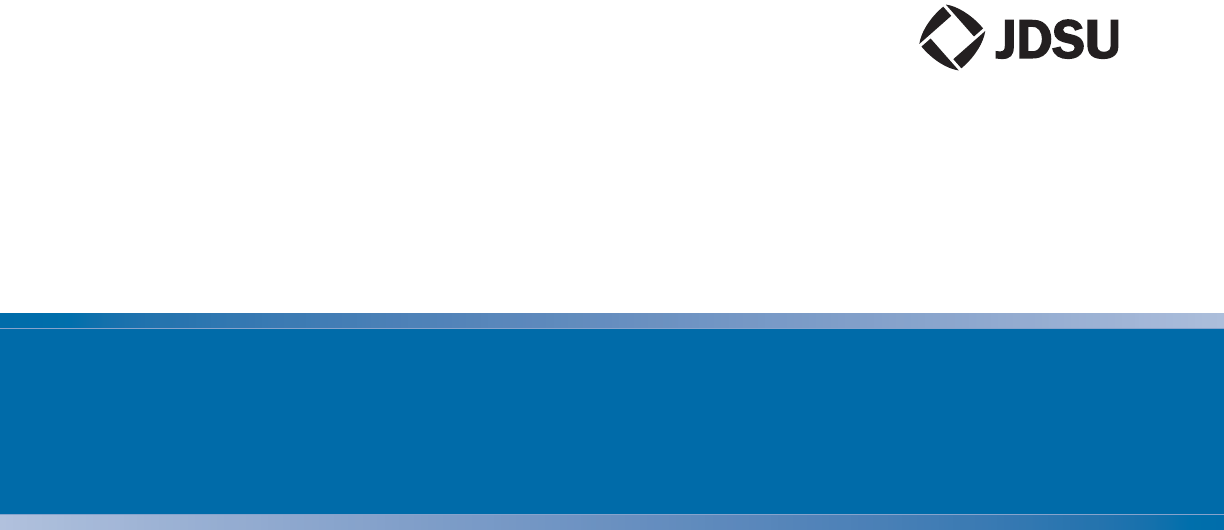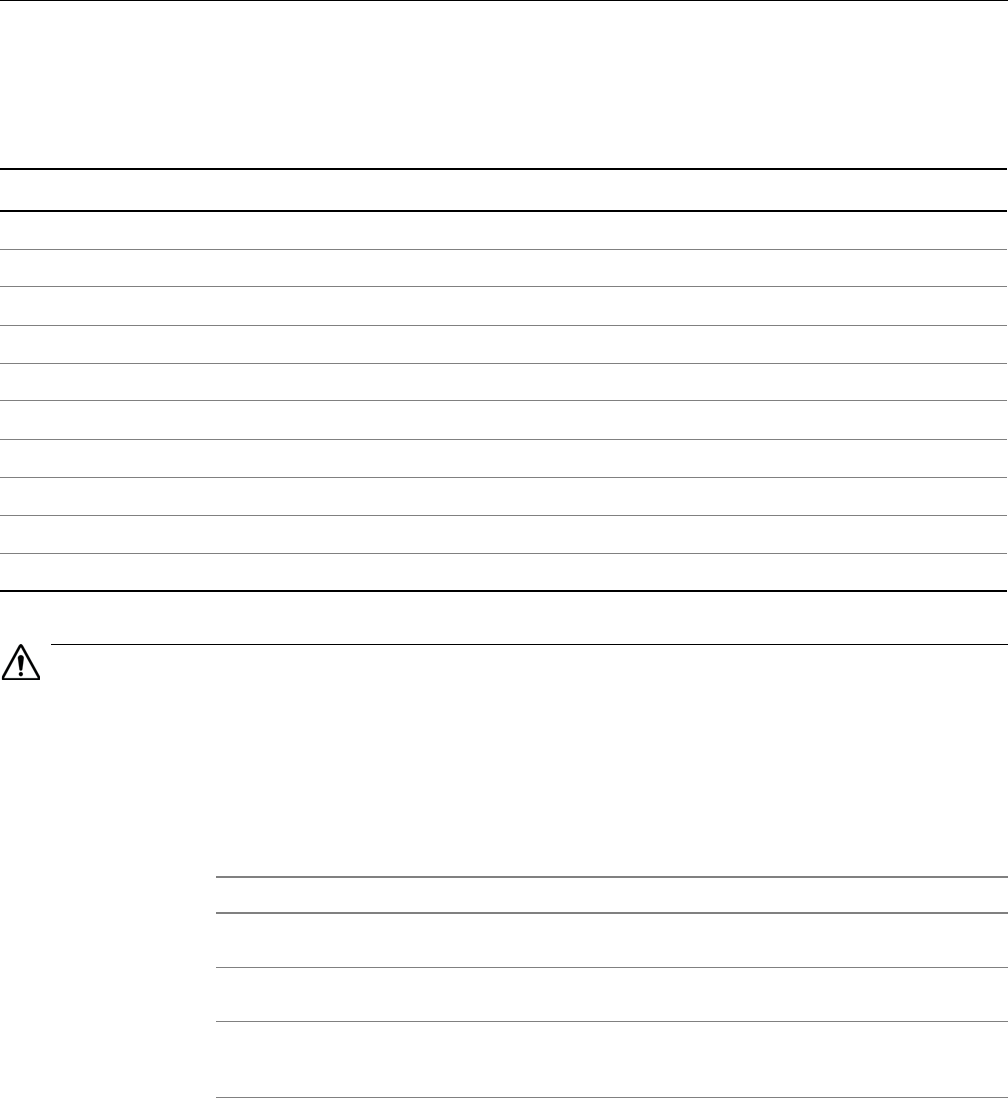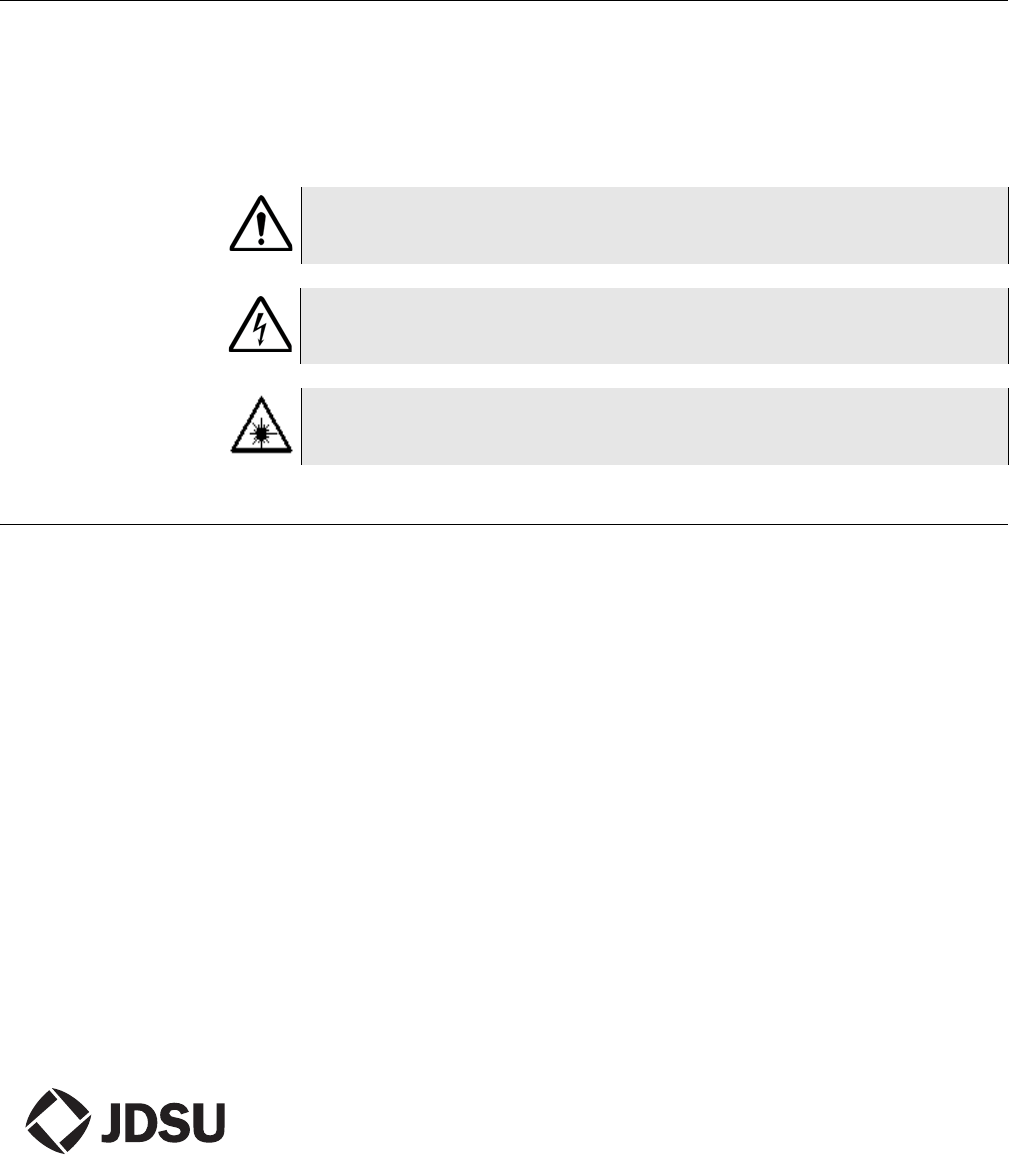Viavi Solutions TBMTS5800 Multirate Handheld Telecommunications Tester (Ethernet, SONET, PDH) User Manual 21148865 TB MTS5800 Safety
Viavi Solutions Inc. Multirate Handheld Telecommunications Tester (Ethernet, SONET, PDH) 21148865 TB MTS5800 Safety
Contents
- 1. Safety Manual
- 2. User Manual
Safety Manual

T-BERD/MTS 5800 Safety Information 1
21148865 rev 000
T-BERD ⁄ MTS 5800 Safety Information
This document provides safety and compliance information for the T-BERD ⁄ MTS 5800.
Topics discussed in this document are as follows:
–“Important safety instructions” on page 2
–“Interfaces and safety classifications” on page 4
–“Consignes de sécurité importantes” on page 4
–“Wichtige Sicherheitsinformationen” on page 6
–“Importanti istruzioni di sicurezza” on page 8
–“Instrucciones de seguridad” on page 10
–“Safety symbols” on page 12
–“Safety standards” on page 12

T-BERD ⁄ MTS 5800 Safety Information
Important safety instructions
2 T-BERD/MTS 5800 Safety Information
Important safety instructions
This booklet contains definitions for safety terms and safety precautions you should follow
when using the T-BERD ⁄ MTS 5800.
Table 1 defines safety terms used in the product documentation. Failure to observe these
precautions while using the T-BERD ⁄ MTS 5800 unit violates the intended use of this
product.
Hazardous voltages caused by lightning strikes or accidental connection to power circuits
may be present on outdoor lines. Such lines are classified as Telecommunications Network
Voltage (TNV) lines. Telecommunications providers employ all reasonable protective
measures to limit dangerous electrical surges on TNV lines. However, absolute protection
from TNV hazards is impossible. Serious injury could result if you do not understand the
hazards of TNV, especially the hazards of lightning strikes and accidental connection to
power circuits. You must be responsible for your own safety by employing proper safety
procedures to minimize the risk of electrical shock. Comprehensive TNV safety training is
beyond the scope of this guide. Still, you should read and understand all safety information
within before using this product.
When using the product, basic safety precautions should always be followed to reduce the
risk of fire, shock, and injury to persons, including the following:
1Read and follow all warning notices and instructions marked on the product and
included in the manual.
2Use only the AC Adapter/Charger supplied with the product. Do not use AC Adapter/
Charger outdoors or in wet or damp locations. Connect the AC Adapter/Charger to the
correct mains voltage as indicated on the ratings label.
3Do not allow anything to rest on the power cord, and do not locate the product where
persons can walk on the power cord.
4This product is intended to be used with a 3-wire grounding-type plug (a plug that has a
grounding pin). This safety feature is vital to the safe operation of the instrument. Do
not defeat the purpose of the grounding-type by modifying the plug or using an
adapter.
5Do not use telephone equipment (other than cordless) during a lightning storm. There
is a possibility of a nearby lightning strike, which could exceed the capacity of the tele-
phone network protective devices and harm you.
Table 1 Safety term definitions
Term Description
DANGER Indicates an imminently hazardous situation which, if not avoided, will result in
death or serious injury.
WARNING Indicates a potentially hazardous situation which, if not avoided, could result in
death or serious injury.
CAUTION Indicates a potentially hazardous situation which, if not avoided, may result in
minor or moderate injury or damage to equipment.
T-BERD ⁄ MTS 5800 Safety Information
Important safety instructions
T-BERD/MTS 5800 Safety Information 3
6Do not use telephone equipment in the vicinity of a gas leak or in any explosive envi-
ronment. This tester, and most other telephone equipment, could in normal operation
generate a spark strong enough to ignite a fire or explosion.
7Do not touch or otherwise come in contact with telephone conductors that could be
exposed to lightning or accidental connection to power circuits without first isolating
them from the telephone network.
8Do not install telephone equipment or terminations (jacks) in wet locations unless the
equipment or termination is specifically designed for such locations.
9Do not cause or allow telephone or telecommunication circuits to come in contact with
power circuits (mains).
10 Do not attempt to service this product yourself, as opening or removing covers may
expose you to dangerous high voltage points and other hazards. Refer all servicing to
qualified service personnel.
11 Use appropriate cables when connecting to telecommunications circuits. Putting an
RJ-11 connector in a RJ-45 port can damage the RJ45 port.
12 WARNING: Danger of extreme heat, fire, or explosion if battery is tampered with.
Replace only with JDSU approved Li-ION battery. Dispose of used batteries according
to the manufacturer's instructions.
13 CAUTION: If the equipment is used in a manner not specified by JDSU, the protection
provided by the equipment may be impaired.
14 Only trained telecommunications technicians who understand the hazards associated
with TNV lines and practice proper procedures for dealing with TNV should use this
tester.
15 Charge the lithium ion battery using only the JDSU battery charger. The battery is to be
used only with JDSU test products.
16 Be sure that TNV signals are not connected to SELV ports. If you need to access a line
that may have TNV or higher voltages present using a SELV port, you must do so
through an interface device that is certified to provide a SELV connection point (see
“Safety classifications of connector ports”).
17 CAUTION: With the maximum allowed optical power input level will be a CLASS 1
LASER PRODUCT.
18 Please see “Safety symbols” for safety symbols. Where the unit is labeled with a
warning symbol, the operating manual must be consulted to learn more about the
nature of the potential hazard and any action that must be taken.
Save these instructions

T-BERD ⁄ MTS 5800 Safety Information
Interfaces and safety classifications
4 T-BERD/MTS 5800 Safety Information
Interfaces and safety classifications
Table 2 lists the T-BERD ⁄ MTS 5800 interfaces, port designations, safety classifications,
and the maximum working voltage of each port.
Consignes de sécurité importantes
Ce livret contient des définitions de termes et des consignes de sécurité que nous vous
conseillons de respecter lorsque vous utilisez votre appareil T-BERD ⁄ MTS 5800.
Le Tableau 3 définit les termes de sécurité utilisés dans la documentation du produit. Le
non-respect de ces consignes lors de l’utilisation de l’appareil T-BERD ⁄ MTS 5800 enfreint
le but pour lequel ce produit a été conçu.
Les lignes extérieures peuvent véhiculer des tensions dangereuses engendrées par la
foudre ou un raccordement accidentel à des circuits d’alimentation électrique. Ce type de
ligne est classé dans la catégorie des lignes à tension de réseau de télécommunication
(TNV). Les fournisseurs de services de télécommunication appliquent toutes les mesures
de protection appropriées afin de limiter les surtensions électriques dangereuses sur les
lignes TNV. Cependant, il est impossible de réaliser une protection absolue contre les
dangers TNV. Vous pourriez gravement vous blesser si vous ne maîtrisez pas les dangers
Table 2 Safety classifications of connector ports
Interface Port Designation Safety Classification Working Voltage
DS1 Rx1, Tx/Rx2 Hazardous Voltage 300 VDC
E3/DS3/STS-1/E4/STM1e Rx1, Tx/Rx2 SELV ± 1 V Unbalanced
E1 Rx1, Tx/Rx2 750ΩSELV 6 Vpp
Ethernet 10/100/1000 SELV 48 V DC ± 5 V balanced
SFP SFP Class 1 laser -------
XFP XFP Class 1 laser -------
Clock EXT CLK SELV 5 V
Headset Headset SELV 5 V
USB USB SELV 5 V
Power 12V SELV 7.2 V
Tableau 3 Terminologie liée à la sécurité
Terme Description
DANGER Indique une situation présentant un danger immédiat qui, si elle n’est pas évi-
tée, engendrera des blessures graves ou mortelles.
ATTENTION Indique une situation présentant un danger potentiel qui, si elle n’est pas évi-
tée, peut engendrer des blessures graves ou mortelles.
PRUDENCE Indique une situation présentant un danger potentiel qui, si elle n’est pas évi-
tée, pourrait engendrer des blessures mineures ou légères, ou une détériora-
tion de l’appareil.
T-BERD ⁄ MTS 5800 Safety Information
Consignes de sécurité importantes
T-BERD/MTS 5800 Safety Information 5
TNV, notamment ceux liés à la foudre et au raccordement accidentel de circuits d’alimenta-
tion électrique. Vous êtes le seul responsable de votre propre sécurité. Par conséquent,
appliquez des procédures de sécurité correctes afin de minimiser le risque d’électrocution.
Le présent livret n’ayant pas pour objectif de dispenser une formation étendue sur la sécu-
rité TNV, lisez attentivement toutes les consignes de sécurité et veillez à les appliquer
correctement avant d’utiliser ce produit.
Lorsque vous utilisez ce produit, plusieurs consignes de sécurité primaires doivent toujours
être appliquées afin de réduire le risque d’incendie, de décharge électrique et de blessure
corporelle :
1Lisez attentivement et respectez tous les avertissements et toutes les instructions figu-
rant sur le produit et dans sa notice.
2Utilisez uniquement l’adaptateur/chargeur CA livré avec le produit. N’utilisez pas cet
accessoire à l’extérieur ou dans des locaux humides. Raccordez-le à la tension de
ligne CA correcte, conformément aux indications de l’étiquette signalétique.
3Ne posez pas d’objet sur le cordon d’alimentation et évitez de placer le produit dans
des endroits à fort passage.
4Ce produit est conçu pour être utilisé avec une prise équipée de la terre (trois fils).
Cette sécurité est indispensable pour une utilisation sans danger de l’appareil. Ne pas
supprimer cette sécurité en modifiant la prise ou en utilisant un adaptateur.
5N’utilisez pas l’équipement téléphonique (autres que sans fil) pendant un orage car il
existe un risque de coup de foudre qui pourrait dépasser la capacité des dispositifs de
protection du réseau téléphonique et vous blesser.
6N’utilisez pas de téléphone à proximité d’une fuite de gaz ou dans un environnement
explosif car en fonctionnement normal, ce testeur pourrait, ainsi que la plupart des
équipements téléphoniques, produire une étincelle qui suffirait à déclencher un
incendie ou une explosion.
7Ne touchez pas ou n’entrez pas en contact avec des conducteurs téléphoniques
susceptibles d’être exposés à la foudre ou à un raccordement accidentel à des circuits
d’alimentation électrique, sans les avoir préalablement isolés du réseau téléphonique.
8N’installez pas l’équipement téléphonique ou ses connecteurs dans des endroits
humides, sauf si ceux-ci ont été spécifiquement conçus pour des environnements de
ce type.
9Ne faites pas contacter ou ne laissez pas le téléphone ou les circuits de télécommuni-
cation des circuits de puissance (secteur).
10 Ne tentez pas de réparer ce produit par vos propres moyens car l’ouverture ou le retrait
de couvercles peut vous exposer à des points de haute tension dangereux et à
d’autres risques. Pour toute réparation, faites appel à un spécialiste qualifié.
11 Employez les câbles appropriés en se reliant aux circuits de télécommunications. La
mise d'un connecteur RJ-11 dans un port RJ-45 peut endommager le port RJ45.
12 ATTENTION : Si vous tentez d’ouvrir la batterie, une situation dangereuse peut appa-
raître (dégagement de chaleur extrême, incendie ou explosion). Remplacez seulement
par la batterie de Li-ION approuvée par JDSU. Eliminez les batteries usagées confor-
mément aux instructions fournies par le fabricant.
13 PRUDENCE : Si cet équipement est utilisé d’une manière non recommandée par
JDSU, la protection intrinsèque pourra être mise en défaut.

T-BERD ⁄ MTS 5800 Safety Information
Wichtige Sicherheitsinformationen
6 T-BERD/MTS 5800 Safety Information
14 Ce testeur doit uniquement être utilisé par des techniciens en télécommunication qual-
ifiés, conscients des risques liés aux lignes TNV et appliquant les procédures correctes
pour les tensions TNV.
15 Dans le chargeur JDSU fourni, chargez uniquement une batterie de type lithium-ion.
Cette batterie doit être exclusivement utilisée avec les produits JDSU.
16 Vérifiez qu’aucun signal TNV n’est transmis aux ports TBTS. Si vous devez accéder à
une ligne susceptible de véhiculer une tension TNV ou supérieure en utilisant un port
TBTS, vous devez intercaler un équipement d’interface certifié pour fournir un point de
raccordement TBTS (voir “Safety classifications of connector ports”).
17 PRUDENCE : Avec le maximum le niveau optique permis de puissance PRODUIT de
laser de la CLASSE 1.
18 Veuillez voir les “Safety symbols” pour des symboles de sûreté. Là où l'unité est
marquée avec un symbole d'avertissement, le operating manual doit être consulté pour
apprendre plus au sujet de la nature du risque et de n'importe quelle mesure qui
doivent être pris.
Mémorisez ces instructions
Wichtige Sicherheitsinformationen
Diese Broschüre enthält eine Begriffsbestimmung sicherheitsrelevanter Fachbegriffe sowie
Sicherheitshinweise, die beim Einsatz des T-BERD ⁄ MTS 5800 zu beachten sind.
Tabelle 4 definiert die in der Produktdokumentation enthaltenen Sicherheitshinweise. Die
Nichteinhaltung dieser Sicherheitshinweise beim Einsatz des T-BERD ⁄ MTS 5800
bedeutet eine nichtbestimmungsgemäße Verwendung des Produktes.
Durch Blitzeinschlag oder versehentlichen Anschluss an Hochspannungsleitungen können
an Außenleitungen, die als TNV-Leitungen (Telecommunications Network Voltage) für den
Anschluss an Telekommunikationsleitungen vorgesehen sind, gefährliche Spannungen
anliegen. Die Telekommunikationsanbieter ergreifen alle angemessenen Schutzmaßnah-
men zur Begrenzung gefährlicher Spannungsspitzen auf TNV-Leitungen. Ein vollständiger
Schutz vor Überspannungen ist jedoch nicht möglich. Die Nichtbeachtung der mit TNV-
Leitungen verbundenen Risiken, insbesondere in Bezug auf Blitzschlag und versehentli-
chen Anschluss an Hochspannungsleitungen, kann zu Verletzungen führen. Daher
müssen Sie auf Ihre eigene Sicherheit achten, indem Sie angemessene Sicherheitsver-
fahren zur Minimierung des Risikos eines elektrischen Stromschlages einsetzen. Eine
umfassende Schulung zu TNV-Sicherheitsmaßnahmen würde den Rahmen dieser
Broschüre sprengen. Trotzdem sollten Sie vor der Arbeit mit dem Produkt alle hierin
enthaltenen Sicherheitshinweise aufmerksam lesen und verstehen.
Tabelle 4 Definition der Sicherheitshinweise
Begriff Beschreibung
GEFAHR Zeigt eine unmittelbar gefährliche Situation an, die bei Nichtbeachtung zu
schweren Verletzungen oder zum Tod führt.
WARNUNG Signalisiert eine potenziell gefährliche Situation, die bei Nichtbeachtung zu
schweren Verletzungen oder zum Tod führen könnte.
VORSICHT Informiert über eine potenziell gefährliche Situation, die bei Nichtbeach-
tung zu leichten oder mittleren Verletzungen oder zu einem Geräte-
schaden führen könnte.
T-BERD ⁄ MTS 5800 Safety Information
Wichtige Sicherheitsinformationen
T-BERD/MTS 5800 Safety Information 7
Zur Verringerung von Brandgefahren, zur Vermeidung eines elektrischen Schlages und
von Verletzungen sind alle grundlegenden Sicherheitsvorkehrungen einzuhalten. Dazu
zählen auch die folgenden Maßnahmen:
1Lesen Sie und beachten Sie alle Warnhinweise und Anweisungen, die auf dem
Produkt angegeben und in der Bedienungsanleitung enthalten sind.
2Verwenden Sie ausschließlich das mit dem Produkt gelieferte Netzteil/Ladegerät.
Verwenden Sie das Netzteil/Ladegerät nicht im Freien oder in feuchten Räumen.
Schließen Sie das Netzteil/Ladegerät nur an die auf dem Typenschild angegebene
Netzspannung an.
3Stellen Sie keine Gegenstände auf das Netzkabel und stellen Sie das Produkt nicht an
Orten auf, an denen Personen auf das Netzkabel treten können.
4Dieses Produkt ist für den Betrieb mit einem Schutzkontaktstecker vorgesehen. Diese
Sicherheitsmaßnahme ist eine Voraussetzung für den sicheren Betrieb des Gerätes.
Jede Manipulation am Stecker oder der Einsatz eines Adapters beeinträchtigt die vom
Schutzkontakt gewährleistete Sicherheit.
5Verwenden Sie während eines Gewitters keine Fernsprecheinrichtungen
(ausgenommen: schnurlose Telefone). Es besteht die Möglichkeit eines nahen
Blitzeinschlages, der die Kapazität der Schutzvorrichtungen der Telefonnetzes über-
schreiten und Sie verletzen könnte.
6Verwenden Sie Fernsprecheinrichtungen nicht in Nähe von ausströmendem Gas oder
in einer explosionsgefährdeten Umgebung. Dieser Tester und die meisten anderen
Fernsprecheinrichtungen könnten im normalen Betrieb einen Funken erzeugen, der so
kräftig ist, dass er einen Brand oder eine Explosion auslösen kann.
7Berühren Sie weder direkt noch indirekt Telefonadern, die durch Blitzschlag gefährdet
sind oder bei denen ein versehentlicher Anschluss an Hochspannungsleitungen
möglich ist, ohne diese zuvor vom Telefonnetz getrennt zu haben.
8Installieren Sie Fernsprecheinrichtungen oder Anschlüsse (Buchsen) nur dann in
Feuchträumen, wenn diese speziell für die Installation an diesen Orten vorgesehen
sind.
9Veranlassen Sie nicht oder lassen Sie Telefon oder Fernmeldeleitungen, mit Energie
Stromkreise (Hauptleitungen) in Berührung zu kommen.
10 Versuchen Sie nicht, dieses Produkt selbst zu warten. Beim Öffnen bzw. Abnehmen
der Abdeckung besteht die Gefahr des Kontaktes mit gefährlichen Spannungsspitzen
und anderer gesundheitlicher Risiken. Die Wartung des Produktes darf nur von
entsprechend qualifizierten Fachkräften ausgeführt werden.
11 Benutzen Sie passende Kabel beim Anschließen an Fernmeldeleitungen. Das
Einsetzen eines Steckers RJ-11 in ein Tor RJ-45 kann das Tor RJ45 beschädigen.
12 WARNUNG: Bei Manipulationen an der Batterie (Akku) besteht die Gefahr einer
starken Erhitzung, eines Brandes oder einer Explosion. Ersetzen Sie nur durch JDSU
genehmigte Li-IONbatterie. Entsorgen Sie gebrauchte Batterien (Akkus) entsprechend
den Anweisungen des Herstellers.
13 VORSICHT: Der Einsatz des Gerätes für andere als von JDSU angegebene Zwecke
kann die vom Gerät gewährleisteten Schutzfunktionen beeinträchtigen.
14 Nur entsprechend ausgebildete Telekommunikationstechniker, die sich der mit TNV-
Leitungen verbundenen Gefahren bewusst sind, und die bei der Arbeit an TNV-
Leitungen alle geltenden Arbeitsvorschriften einhalten, dürfen diesen Tester
verwenden.

T-BERD ⁄ MTS 5800 Safety Information
Importanti istruzioni di sicurezza
8 T-BERD/MTS 5800 Safety Information
15 Laden Sie den Lithium-Ionen-Akku nur mit dem von JDSU gelieferten Ladegerät. Der
Akku darf nur mit Testsprodukten von JDSU eingesetzt werden.
16 Achten Sie darauf, dass TNV-Signale nicht an SELV-Anschlüsse angeschlossen
werden. Wenn Sie auf eine Leitung, an der TNV-Spannung oder höhere Spannungen
anliegen können, über einen SELV-Anschluss zugreifen, dann müssen Sie hierfür ein
Schnittstellengerät verwenden, das nachweislich einen SELV-Anschlusspunkt bereits-
tellt (sehen Sie “Safety classifications of connector ports”).
17 VORSICHT: Mit dem Maximum ist erlaubtes optisches Energie Eingang Niveau d ein
KATEGORIE 1 Laser PRODUKT.
18 Sehen Sie bitte “Safety symbols” für Sicherheit Symbole. Wo die Maßeinheit mit einem
Warnsymbol beschriftet wird, muß das operating manual beraten werden, um mehr
über die Natur der möglichen Gefahr und aller möglicher Maßnahmen zu erlernen, die
ergriffen werden müssen.
Bewahren Sie diese Hinweise auf
Importanti istruzioni di sicurezza
Questo documento contiene definizioni dei termini riguardanti la sicurezza e illustra le
precauzioni a cui attenersi quando si utilizzano prodotti T-BERD ⁄ MTS 5800.
La Tabella 5 riporta le definizioni dei termini riguardanti la sicurezza utilizzati nella docu-
mentazione dei prodotti. La mancata osservanza di tali precauzioni durante l'utilizzo
dell'unità T-BERD ⁄ MTS 5800 viola la destinazione d'uso di questo prodotto.
Nelle linee esterne possono essere presenti tensioni pericolose provocate da colpi di
fulmine o da collegamenti accidentali con i circuiti di potenza. Tali linee sono classificate
come circuiti di tensione delle reti per telecomunicazioni (TNV, Telecommunications
Network Voltage). I fornitori di telecomunicazioni adottano tutte le opportune misure protet-
tive per limitare pericolose sovracorrenti nelle linee TNV. È tuttavia impossibile ottenere una
protezione assoluta dai pericoli inerenti alla tensione TNV. La mancata comprensione dei
rischi legati alla tensione TNV (in particolar modo per quanto riguarda i lampi e il collega-
mento accidentale a circuiti di alimentazione) può provocare gravi lesioni. L'utente è
responsabile della propria sicurezza ed è quindi tenuto ad adottare procedure idonee per
ridurre al minimo il rischio di scosse elettriche. Un addestramento completo in materia di
sicurezza dei circuiti di tensione delle reti per telecomunicazione (TNV) esula dagli scopi
della presente guida. È però necessario che l'utente legga e comprenda tutte le informaz-
ioni relative alla sicurezza contenute nella presente guida prima di utilizzare il prodotto.
Quando utilizza il prodotto, l'utente dovrà sempre adottare precauzioni di base per ridurre
il rischio di incendi, scosse elettriche e lesioni a terzi. Le precauzioni comprendono quanto
riportato di seguito.
Tabella 5 Definizioni di sicurezza
Termine Descrizione
PERICOLO Indica una situazione di pericolo imminente che, se non evitata, pro-
vocherà la morte o gravi lesioni.
AVVERTENZA Indica una situazione di pericolo potenziale che, se non evitata, potrebbe
provocare la morte o gravi lesioni.
ATTENZIONE Indica una situazione di pericolo potenziale che, se non evitata, potrebbe
provocare lesioni di lieve o moderata entità oppure danni all'attrezzatura.
T-BERD ⁄ MTS 5800 Safety Information
Importanti istruzioni di sicurezza
T-BERD/MTS 5800 Safety Information 9
1Leggere e osservare tutte le avvertenze e istruzioni riportate sul prodotto e contenute
nel manuale.
2Utilizzare esclusivamente l'adattatore AC/caricabatterie fornito insieme al prodotto.
Non utilizzare l'adattatore AC/caricabatterie in esterni oppure in luoghi umidi o bagnati.
Collegare l'adattatore AC/caricabatterie alla tensione di rete corretta secondo quanto
riportato sull'apposita etichetta.
3Non appoggiare alcun oggetto al cavo di alimentazione e non collocare il prodotto in
punti in cui il cavo potrebbe venir calpestato.
4Questo prodotto è progettato per essere usato con cavo di alimentazione a tre fili che
includa il collegamento di terra (munito di spina con collegamento di terra). Questa
modalità di collegamento è vitale per operare in sicurezza con lo strumento. Non vani-
ficare l'efficacia del collegamento di terra modificandolo od utilizzando un collega-
mento diverso da quello fornito con lo strumento.
5Non utilizzare l'apparecchio telefonico (tranne che nel caso di cordless) durante un
temporale elettrico. Esiste la possibilità di colpi di fulmine che superano la capacità dei
dispositivi di protezione della rete telefonica.
6Non utilizzare l'impianto telefonico in prossimità di perdite di gas o in ambienti con
esplosivi. In condizioni di funzionamento normale, questo dispositivo di testing, e la
maggior parte degli altri apparecchi telefonici, possono generare scintille sufficienti a
provocare fiamme o esplosioni.
7Non toccare né entrare in altro modo in contatto con conduttori telefonici che possono
essere stati colpiti da fulmini o collegati accidentalmente a circuiti di potenza senza
aver prima provveduto a isolarli dalla rete telefonica.
8Non installare l'impianto o le terminazioni (jack) telefonici in luoghi umidi a meno che
non siano stati appositamente progettati per ubicazioni di tale tipo.
9Non induca o che non lasci che il telefono o i circuiti di telecomunicazione contatti i
circuiti di alimentazione (condutture).
10 Non cercare di riparare da soli il prodotto; l'apertura o la rimozione dei coperchi potreb-
bero esporre l'utente a tensione pericolosa e ad altri rischi. Rivolgersi a personale qual-
ificato per tutte le operazioni di manutenzione.
11 Usi i cavi adatti quando collegano ai circuiti di telecomunicazioni. Mettendo un connet-
tore RJ-11 in un orificio RJ-45 può danneggiare l'orificio RJ45.
12 AVVERTENZA: pericolo di estremo calore, incendio o esplosione in caso di manomis-
sione della batteria. Sostituisca soltanto con la batteria dello Li-IONE approvata JDSU.
Smaltire le batterie usate secondo le istruzioni della casa produttrice.
13 ATTENZIONE: se l'impianto viene utilizzato in modo diverso da quello specificato da
JDSU, ciò potrebbe compromettere la protezione fornita.
14 L'uso di questo dispositivo di testing è riservato a tecnici delle telecomunicazioni
opportunamente addestrati in grado di comprendere i rischi associati ai circuiti TNV e
di gestire in modo idoneo la tensione TNV.
15 Per ricaricare la batteria agli ioni di litio, utilizzare esclusivamente il caricabatterie
JDSU. La batteria va utilizzata esclusivamente con i prodotti JDSU.
16 Verificare che i segnali TNV non siano collegati a porte SELV. Nel caso in cui sia
necessario accedere a una linea nella quale sono presenti tensioni TNV o alte tensioni
di altro tipo utilizzando una porta SELV, utilizzare un dispositivo di interfaccia
omologato per la fornitura di un punto di collegamento SELV (vedi la “Safety classifica-
tions of connector ports”).

T-BERD ⁄ MTS 5800 Safety Information
Instrucciones de seguridad
10 T-BERD/MTS 5800 Safety Information
17 ATTENZIONE: Con il massimo il livello di input ottico permesso di potere sarà un
PRODOTTO del laser del CODICE CATEGORIA 3B.
18 Veda prego “Safety symbols” per i simboli di sicurezza. Dove l'unità è identificata con
un simbolo d'avvertimento, il operating manual deve essere consultato per imparare
più circa la natura del rischio potenziale e di tutta l'azione che devono essere
intrapresi.
Conservare queste istruzioni
Instrucciones de seguridad
Este folleto contiene las definiciones de los términos de seguridad y las precauciones que
deben tomarse durante la utilización del T-BERD ⁄ MTS 5800.
La Tabla 6 define los términos de seguridad empleados en la documentación del producto.
La inobservancia de estas precauciones viola las condiciones de uso de este producto.
En las líneas tendidas al aire libre pueden existir tensiones peligrosas causadas por rayos
o conexiones accidentales a circuitos de alimentación. Tales líneas se denominan TNV
(tensión de redes telecomunicaciones). Los proveedores de telecomunicaciones utilizan
todas las medidas de protección razonables para limitar las sobretensiones en las líneas
TNV. Sin embargo, no es posible lograr una protección total contra descargas o conexiones
accidentales a fuentes de energía eléctrica. Puesto que es imposible un diseño que posea
una seguridad absoluta, el usuario debe responsabilizarse de su propia seguridad y utilizar
los procedimientos TNV adecuados para minimizar el riesgo de descargas eléctricas. La
explicación de los procedimientos de seguridad TNV es un tema que queda fuera del
ámbito de este folleto. Aún así, es importante que usted lea y comprenda toda la infor-
mación de seguridad antes de utilizar este equipo.
Cuando use este producto, observe en todo momento ciertas precauciones básicas para
reducir el peligro de incendios, golpes y lesiones personales, incluyendo:
1Lea y observe todas las notas de seguridad indicadas en el producto, así como las
incluidas en este folleto y en la guía del usuario.
2No utilice un adaptador/cargador de alterna distinto al incluido con este producto. No lo
emplee en exteriores ni en lugares mojados o muy húmedos. Conecte el adaptador/
cargador de alterna a la tensión de red correcta, indicada en la etiqueta del instru-
mento.
3No aplaste el cable de alimentación. No coloque el instrumento de forma que alguien
pueda pisar accidentalmente el cable de alimentación.
Tabla 6 Definiciones de seguridad
Término Descripción
PELIGRO Indica una situación peligrosa inminente que, si no se evita, puede resul-
tar mortal o causar lesiones graves.
ATENCION Indica una situación potencialmente peligrosa que, si no se evita, puede
resultar mortal o causar lesiones graves.
PRECAUCION Indica una situación potencialmente peligrosa que, si no se evita, puede
causar lesiones leves o moderadas.
T-BERD ⁄ MTS 5800 Safety Information
Instrucciones de seguridad
T-BERD/MTS 5800 Safety Information 11
4Este producto está diseñado para ser utilizado con cable con conexión a tierra (cable
con banana/pin tierra). Esta protección es vital para la operación segura del equipo.
No obstaculicen el propósito de la conexión a tierra modificando el cable o utilizando
un adaptador
5Evite el uso de equipos telefónicos fijos durante las tormentas con aparato eléctrico.
Cualquier rayo caído en las proximidades podría exceder la capacidad de los disposi-
tivos de protección de la red telefónica y causar daños personales.
6No utilice equipos telefónicos en las proximidades de lugares con pérdidas de gas o
en entornos relacionados con atmósferas explosivas. Este instrumento, como la
mayoría de equipos telefónicos, podría generar una chispa capaz de iniciar un
incendio o provocar una explosión.
7No toque conductores telefónicos que pudieran estar expuestos a rayos o a conex-
iones accidentales con circuitos de alimentación, sin aislarlos previamente de la red
telefónica.
8No instale equipos telefónicos ni terminaciones (tomas de red) en lugares húmedos, a
menos que los equipos o terminaciones hayan sido diseñados específicamente para
dichos lugares.
9No haga ni permita que el teléfono o los circuitos de telecomunicación venga en
contacto con los circuitos de la energía (cañerías).
10 No trate de reparar este producto. Al abrir o quitar las cubiertas pueden quedar al
descubierto elementos con tensiones elevadas. Consulte a un técnico de asistencia
cualificado.
11 Utilice los cables apropiados al conectar con los circuitos de telecomunicaciones.
Poner un conectador RJ-11 en un puerto RJ-45 puede dañar el puerto RJ45.
12 ATENCIÓN: Existe riesgo de incendio o explosión si se sustituye la batería por una
batería no adecuada. Substituya solamente por la batería aprobada JDSU del Li-ION.
Para desechar las baterías siga las instrucciones del fabricante.
13 PRECAUCIÓN: Si este equipo se utiliza de forma distinta a lo especificado por JDSU,
los mecanismos de protección previstos pueden dejar de funcionar u operar inadecua-
damente.
14 Este instrumento debe ser utilizado por técnicos experimentados que conozcan los
riesgos asociados a las líneas TNV y empleen los procedimientos de seguridad apro-
piados.
15 Para cargar la batería litio-ion, utilice siempre el cargador recomendado por JDSU. La
batería debe usarse exclusivamente en equipos de JDSU.
16 Las señales TNV no deben conectarse a los puertos SELV. Si necesita acceder con un
puerto SELV a una línea que pueda tener tensiones TNV o superiores, use un disposi-
tivo de interfaz capaz de proporcionar un puerto SELV (vea el “Safety classifications of
connector ports”).
17 PRECAUCIÓN: Con el máximo el nivel de introducción de datos óptico permitido de
energía será un PRODUCTO del laser de la CLASE 1.
18 Vea por favor los “Safety symbols” para los símbolos de seguridad. Donde la unidad se
etiqueta con un símbolo amonestador, el operating manual se debe consultar para
aprender más sobre la naturaleza del peligro potencial y de cualquier acción que
deban ser tomados.
Guarde estas instrucciones

Communications Test and Measurement Solutions
12410 Milestone Center Drive
Germantown, Maryland 20876-7100 USA
Toll Free 1-800-638-2049 • Tel +1-240-404-2999 • Fax +1-240-404-2195
www.jdsu.com
© Copyright 2011 JDSU. All rights reserved. JDSU, Enabling Broadband and Optical Innovation, Communications Test and Measurement
Solutions, and their logos are trademarks of JDSU. All other trademarks and registered trademarks are the property of their respective
owners. Specifications, terms, and conditions are subject to change without notice.
12 T-BERD/MTS 5800 Safety Information April 2011
T-BERD ⁄ MTS 5800 Safety Information
Safety symbols
Safety symbols
The following safety symbols are used on the T-BERD ⁄ MTS 5800. All safety precautions
must be observed when operating, servicing, or repairing the T-BERD ⁄ MTS 5800 unit.
Failure to comply with the following safety precautions or with hazards, dangers, warnings,
and cautions used throughout this document or related manuals violates the intended use
of this instrument.
Safety standards
This section lists the safety standards that apply to the T-BERD ⁄ MTS 5800. The
T-BERD ⁄ MTS 5800 meets the following standards:
– UL 3111-1, First Edition, Rev. 06/30/94: The Standard for Electrical Equipment for
Laboratory Use; Part 1 (Equivalent to UL 61010B-1)
– CAN/CSA-C22.2 No 1010.1, 1992 Edition, Rev. 02/97: The Standard for Safety for
Electrical Equipment for Measurement, Control, and Laboratory Use, Part 1
– UL 60950, Third Edition: 2000, Rev March 15, 2002: Safety of Information Technology
Equipment (applicable TNV clauses)
– CAN/CSA 60950-00: Safety of Information Technology Equipment (applicable TNV
clauses)
– EN 61010-1, March 2001: Safety Requirements for Electrical Equipment for Measure-
ment, Control, and Laboratory Use, Part 1
CAUTION
This symbol indicates a general caution hazard.
ELECTRICAL SHOCK HAZARD
This symbol indicates an electrical shock hazard.
LASER HAZARD
This symbol indicates a laser hazard.